
Small forest river, Corcovado Nat'l Park, Costa Rica.
Swimming in rainforest rivers
Our species has first evolved along tropical river banks - we
still have a lot of adaptations for swimming and diving. For some reason, in our
time most people think of tropical rivers as a place to be infected by parasites
or be eaten by crocodiles, anacondas, cannibals... you name it. Traveling in a
rainforest, I discovered (for myself - some people had already done it before),
that swimming in rainforest rivers is a comfortable and relatively safe way of
getting around, and one of the best ways of seeing wildlife.
|
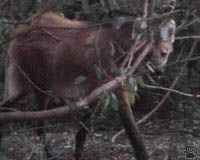 |
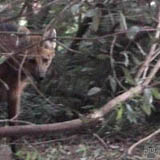 |
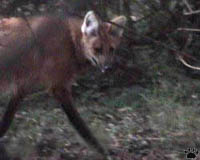 |
| Maned wolf (Chrysocyon
brachyurus ), Parque Nacional Rio Pilcomayo, Paraguay. |
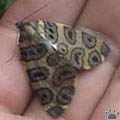 |
 |
Alas, it's not the best way to take
photos, even with a waterproof camera. |
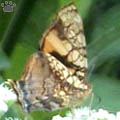 |
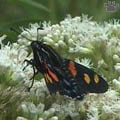 |
| Geometrid moth, Parque
Nacional Calilegua, Argentina. |
Butterflies, Parque
Nacional Calilegua, Argentina. |
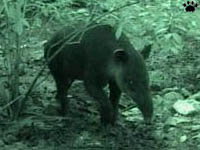 | 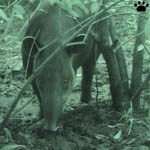 | 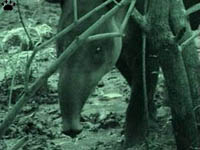 | | Baird's, or Central
American, tapir (Tapirus bairdii), Crooked Tree Wildlife Sanctuary, Belize. |

Brazilian tapir
(Tapirus terrestris),
Rio Alto Manu,
Peru. |
I've often tried this way of travelling
on Rio Manu, Peru. It flows through the World's most diverse nature reserve, it
isn't too swift, nor too slow, it's usually cool in daylight hours and warm at
night. What is even better, it meanders so much that in some places you can drift
downstream for miles and then come back by foot in half an hour. You can also
swim from one ranger station to another, or arrange a boat to pick you up. You
can stay in the water for hours and still feel comfortable. |
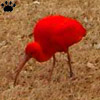
Scarlet ibis
(Eudocimus ruber), Chechereviche,
Venezuela. |
 |
 |
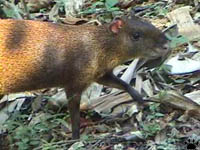 |
| Central American agouti
(Dasyprocta punctata), Finca Ecologica, Costa Rica. |
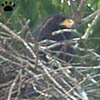
Hawk Buteogallus
subtilis at nest,
Corcovado, Costa Rica. |
The main advantage of this method
is that only your head is above the water, so the wildlife doesn't realize you
are human, and pays little or no attention to you. From the river, you can see
animals which are normally extremely difficult to get a glimpse of: tapirs, ocelots,
bush dogs, harpy eagles, and jaguars. Once
I saw three jaguars in one day! Well, it was the first day of the rainy season,
and all wildlife was on the move, but you can always count on excellent sightings. |
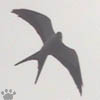
Kite Elanoides
forficatus, Cerro de la
Muerte, Costa Rica. |
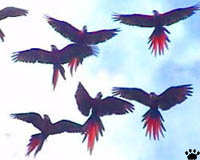 |
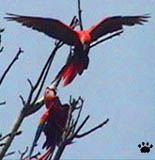 |
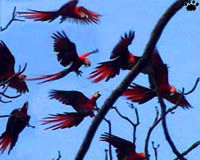 |
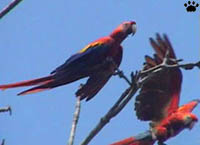 |
Scarlet macaws (Ara macaw)
playing in the wind, Corcovado, Costa Rica.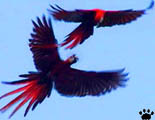 |
 |
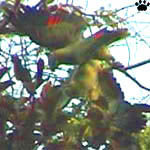
Fighting amazons (Amazona
autimnals), Corcovado, Costa Rica. |
In the Upper Amazon and other lowlands,
it is a good idea to ask local people about locations of colpas on river
banks. Colpas are mineral deposits often visited by wildlife. In Manu area, there
are two world-famous colpas de guacamayos, visited daily by huge flocks
of macaws and smaller parrots. Costa Rica's Corcovado Nat'l Park also has colpas,
but few people know about them. |
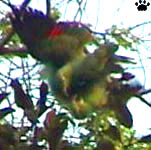
Fighting amazons (Amazona
autimnals), Corcovado, Costa Rica. |
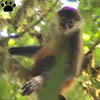 |
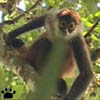 |
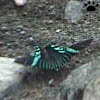 | 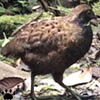 |
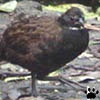 |
Central American spider monkey
(Ateles geoffroyi),
Corcovado, Costa Rica. |
Urania leilus moth,
La Selva, Costa Rica. |
Black-breasted wood
quail (Odontoporus
leucolaemus), Braulio Carillo Nat'l Park, Costa Rica. |

Red brockett deer (Mazama americana), Manu. |
Other colpas are visited (mostly at
night) by gallinaceous birds (for pebbles, I think), ungulates, larger rodents,
monkeys, butterflies and moths. The deer on the photo to the left was photographed
on such a colpa from a tree. |

Black guan (Pipile unicolor),
Monteverde, Costa Rica. |
 | 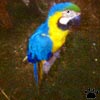 |  | 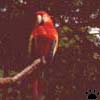 |
| Common visitors of colpas
in Manu, left to right: red-billed parrot (Pionus sordidus), blue-and-yellow
macaw (A. ararauna), military macaw (A. militaris), scarlet macaw
(A. macao). |
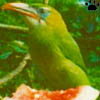
Groove-billed toucanet
(Aulacorhynchus
sulcatus), Rancho
Grande, Venezuela. |
It's a good idea is to create bait
stations along the river banks. Fruit and seeds placed in traditional bird feeders
will attract all kinds of birds; raw meat is good for birds of prey; same meat
hanging on a low branch would lure carnivores; a pile of grain would get you good
views of rodents. You can also try to attract ungulates to river banks if you
have enough salt or fruit. After making bait stations, you can use them for weeks,
swimming by and watching your guests. |
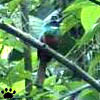
Rufous-tailed jacamar
(Galbula ruficauda),
Monteverde,
Costa Rica. |
 |
Tanagers and honeycreepers are usually
the most colorful visitors to Neotropic bird feeders. Upper row: Ramphocelus
passerinii (males and females); second row - male R. sanguinolenta
with male Chlorophanes spiza (left), female Ch. spiza (center),
Tangara larvata with Piranga flava (right); third row: male Cyanerpes
cyaneus with thrush Turdus grayi (left) and with Thraupis palmorum
(right), bottom row, left to right: Chlorospingus canigularis, Th. episcopus,
P. flava, P. rubra. Arenal Observatory, Costa Rica. |
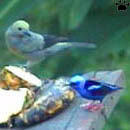 |
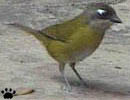 |
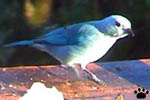 |  |
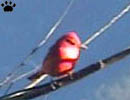 |

Groove-billed toucanet
(Aulacorhynchus
sulcatus), Rancho
Grande, Venezuela. | 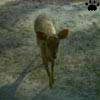
Rare pampas deer
(Ozotocercus
besoarticus), Chaco
Nat'l Park, Argentina |
This method worked well in savannas
and dry forests along Uruguay and Parana rivers. Once I observed 11 species of
birds and 3 species of mammals feeding on a pile of fruit together. |

Mara (Dolichotis
salinicola), a large
hare-like rodent of
Pantanal, Brazil |
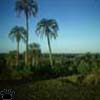
Open palm savanna of
El Palmar Nat'l Park, Argentina - a great place
to look for wildlife. |

Agouti D. fuliginosa,
Manu. |

Nest of lesser hornero
(Furnarius minor),
Jatun Sacha, Ecuador. |
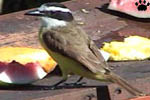
Greater kiskadee
(Pitangus sulphuratus),
Arenal Observatory, Costa Rica. |
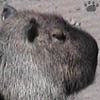
Capybara (Hydrochoerus hydrochoerus),
Pantanal, Brazil. |
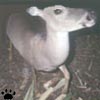
Gray mazama deer (M.
gouazoupira), Manu. |
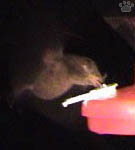
Anoura geoffroyi bat,
Monteverde, Costa Rica. |

Glossophaga leachi
bat, Monteverde. |
Hummingbird feeders attract not just
birds, but also mammals and insects, especially at night. |
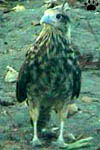
Saturnid moth,
La Selva, Costa Rica. |
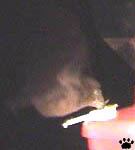
G. soricina bat,
Monteverde. |
 |
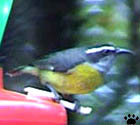 |
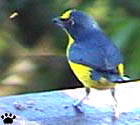 |
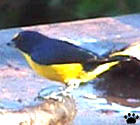 |
Bananaquit (Coereba
flaveola),
Monteverde, Costa Rica. |
Yellow-throated euphonia
(Euphonia hirundinacea),
Arenal Observatory, Costa Rica. |
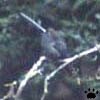
Green-fronted lancebill
(Doryfera ludovicae),
Monteverde, Costa Rica. |
Unfortunately, not all species of hummingbirds
can be attracted to feeders. Some, like lancebills and swordbills (Ensifera),
can't use them because of bill shape. Others, like hermits (Phaethornis),
prefer to stay in deep forest. Small species are often chased away from feeders
by larger ones. To see them all, you still have to hike/swim into the forest,
looking for flowering trees and shrubs. |

Green-fronted lancebill
(Doryfera ludovicae),
Monteverde, Costa Rica. |
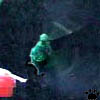 |
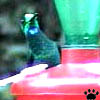 |
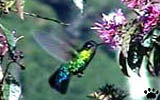 |
 |
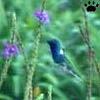 |
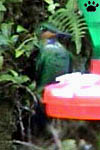 |
 |
Feeder-visiting hummingbirds of
Central America, upper row, left to right: Campylopterus hemileucurus (3
photos), C. cuvierii, Heliodoxa jacula; second row - H. jacula (2
photos), Chlorostilbon mellisugus, Elvira cupreiceps, Florisuga
mellivora; third row - Colibri thalassinus (2 photos), Lampornis
castaneiventris (2 photos); bottom row - L. castaneiventris (2 photos),
Calliphlox bryantae ( 2 photos), C. thalassinus. Monteverde, Costa
Rica. |
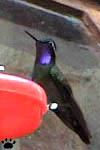 |
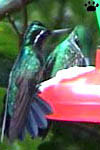 |
 |
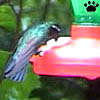 |
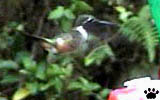 |
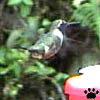 |
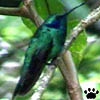 |

Rufous-tailed jacamar
(Galbula ruficauda),
Monteverde, Costa Rica. |
Oxbow lakes are of special interest. Their flora
and fauna are completely different from what you normally find in rivers. Besides,
water is often transparent there, making oxbow lakes (called cochas in
Western Amazon) excellent sites for snorkeling. Giant otters, hoatzins , and many
beautiful wading birds can be found here, along with many small "aquarium"
fishes. |
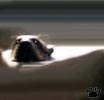
Giant otter (Pteronura
brazilensis), Manu
Nat'l Park, Peru. |
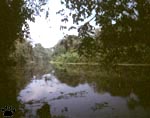
Cocha Otorongo (Jaguar Lake), Manu. | 
Hoatzin (Opisthocomus hoatzin), Cocha Cashi, Manu. |

Oxbow lake, Chaco Nat. Park, Argentina. |

Water lily (Nymphaea),
Tortuguero, Costa Rica. |
The immense system of fresh- and saltwater channels
of Mosquito Coast (Caribbean side of Costa Rica, Nicaragua and Honduras) is another
type of landscape best explored by swimming. Avoid "touristic" channels,
and don't get too close to shore at night - some local mosquitoes are carrying
malaria. Don't be scared by giant tarpons (Megalops atlanticus) splashing
around - they are harmless. |

Passiflora flower,
Corcovado, Costa Rica. |
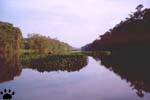 | 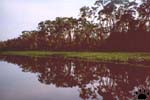 | 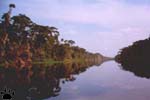 | | Beautiful channels of
Mosquito Coast can be followed for hundreds of miles. |
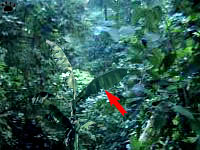
Honduran white bat (Ectophylla album) is the
only bat endemic to Central America. It is the
size of a ping pong ball, with snow-white fur
and golden-yellow wings, ears, and nose.
Families of these bats spend days in tents made
of banana or Heliconia leaves. |
Mosquito Coast is also a great place to search for bat tents.
Look for folded or strangely hanging leaves of bananas, heliconias and palms along
forest trails and waterways. Of about six tent-making species in the area, white
bat is the smallest, the cutest, and the most difficult to find. | 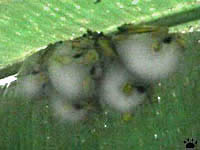
Sunlight coming through the leaf makes their
white fur look green. Finding such tents in the
rainforest isn't easy, but once found, the bats can
sometimes be petted or even hand-fed. Other
tent-making bat species are much less tame.
La Selva, Costa Rica. |
 |
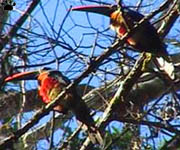 |
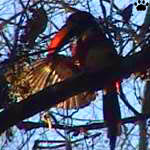 |
| Fiery-billed aracaris
(Pteroglossus frantzii), Corcovado, Costa Rica. |
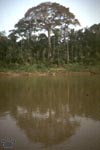
Blooming seiba (Seiba
pintandra), Manu Nat'l
Park, Peru. |
Flowering and fruiting trees always
attract wildlife, from insects to tapirs. If you find a large tree with lots of
flowers or fruit on a river bank, it's a good idea to visit this place every few
hours, day and night. Don't forget to look underwater: many fish species of tropical
rivers feed on fallen fruit and flower petals. Bats, monkeys, toucans, parrots,
trogons, hummingbirds are regular visitors of such trees in the Neotropics. In
the Paleotropics, expect to see elephants, rhinos and other large mammals in their
shade; sunbirds, flowerpeckers, moths, and fruit bats - in their canopy. |
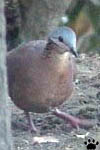
DoveGeotrygon
chiriquensis, Finca
Ecologica, Costa Rica. |
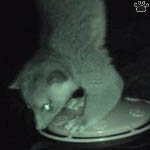 | 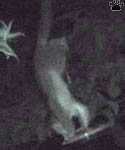 |  |  | | Olingo (Bassaricyon gabbi), at a hummingbird feeder, Monteverde, Costa Rica. |
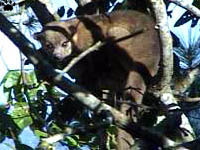
Kinkajou (Potos flavus) near bird feeders,
Arenal Observatory, Costa Rica. | Kinkajous and olingos (arboreal animals of raccoon family)
regularly visit fruiting and blooming trees, and occasionally - bird feeders.
Their relatives, kakomitzles (Bassariscus sumichrasti), also show up sometimes. | 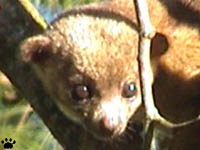
Kinkajou (Potos flavus) near bird feeders,
Arenal Observatory, Costa Rica. |
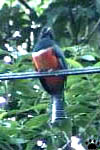 |
 |
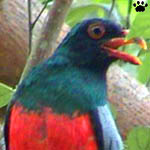 |
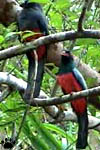 |
 |
| Trogons Trogon collaris (two left pictures) and T. massena, Costa Rica. |

Red-tailed hawk (Buteo
jamaicensis), Costa Rica. | 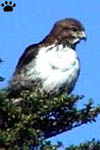
Red-tailed hawk,
Costa Rica. |
Carnivores, such as birds of prey,
also visit them often, attracted by abundant prey. |

Caracara Milvago
chimachima, Panama. | 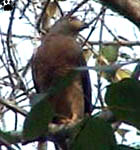
Kite Chondrohierax
uncinatus, Costa Rica. |
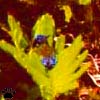 | 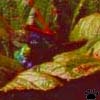 |  |  | 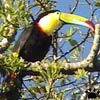 | Blue-crowned woodnymph
(Chlorostilbon colombica),
forest edge hummingbird, Sierra del Muerte, Costa Rica. | Harpy eagle
(Harpia harpyja), Manu. | Toucans Rhamphastos
ambiguus and Rh. sulfuratus,
Corcovado, Costa Rica. |

Abandoned plantation,
Rio Napo, Ecuador. |
Old clearings and abandoned plantations are also
"hotspots". Here you can see many canopy species of birds, bats and
butterflies on eye level. Semy-synantropic creatures, such as tairas (Eira
barbata), and coatis (Nasua) often visit such places. |
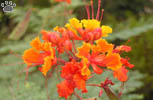
Caesalpinia shrubs are common on
many abandoned plantations. |
 |
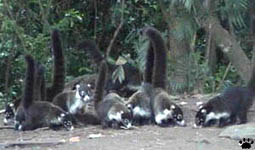 |
 |
| White-nosed coatis (N.
narica), Costa Rica. Note the difference in color between highland (center)
and lowland populations. |

Ameiva lizard, Corcovado. |
Beetles, rodents and lizards are also very interesting
in places with decaying logs. Woodpeckers and other birds such as motmots are
attracted to insects breeding in dead wood. |
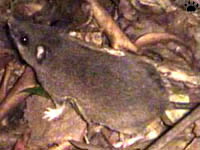
Oryzomus alfari rat, Finca Ecologica. |
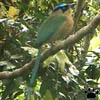 |
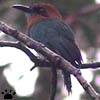 |
 |  |
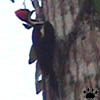 |
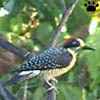 |
| Motmots and woodpeckers of Central
America, left to right: Momotus momota, M. platyrhynchum, M.
martii, Dryocopus lineatus (2 photos), Melanerpes pucherani.
Costa Rica. |
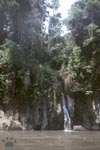
Waterfall, Rio Napo,
Ecuador. |
When swimming in rainforest rivers, pay special
attention to mouths of tributaries. Small creeks entering main channel are often
biodiversity hotspots. Turtles, crocs, crab-eating raccoons (Procyon cancrivorous),
dozens of interesting fish species are most easy to see in such places. By entering
small streams, you get a chance to see Neotropic otters (Lontra longicaudis),
water opossums (Chironectes minimus), pacas (Agouti paca), various
fish-eating rats and reptiles. Small waterfalls provide moisture and oxygen-rich
water for many species of amphibians and rare plants. |
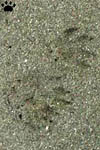
Tracks of crab-eating
raccoon, Corcovado. |
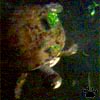 | 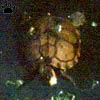 | 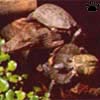 | | Assorted turtles and
American crocodile (Crocodylus acutus), Venezuela. |
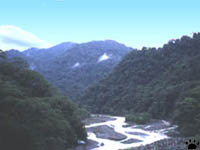
Rio Sucio, Braulio Carillo NP, Costa Rica. |
It's better to undertake swimming trips during
the dry season, when most of sunken logs and stumps are visible, wildlife is staying
close to water sources, and there are nice shallows to rest on, watching butterflies,
skimmers, terns and lizards. |
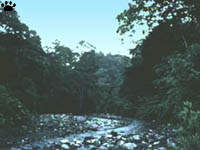
Rio Rincon, Corcovado Nat'l Park, Costa Rica. |
 |
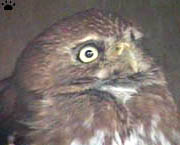 |
 |
 |
| Nocturnal birds of riparian forests,
left to righ: Asio clamator, Glaucidium brasilianum (2 photos),
Nyctibius grandis. Corcovado, Costa Rica. |
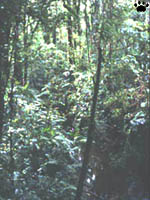
Overgrown forest stream,
Corcovado Nat'l Park, Costa Rica. |
You can also walk up small streams more easily
during the dry season. Many birds of riparian forest nest during dry months to
avoid flooding of their nests. Swimming in mountain or foothill rivers, try not
to get caught by sudden rain - the river can rapidly turn cold, very swift, and
can smash you into some underwater tree trunk.

Dry season haze above Rio Manu, Peru. |
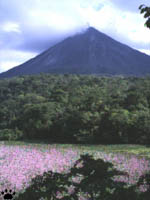
Water hyacinth-covered lake near
Volcan Arenal, Costa Rica. |
Part 2
Home
|